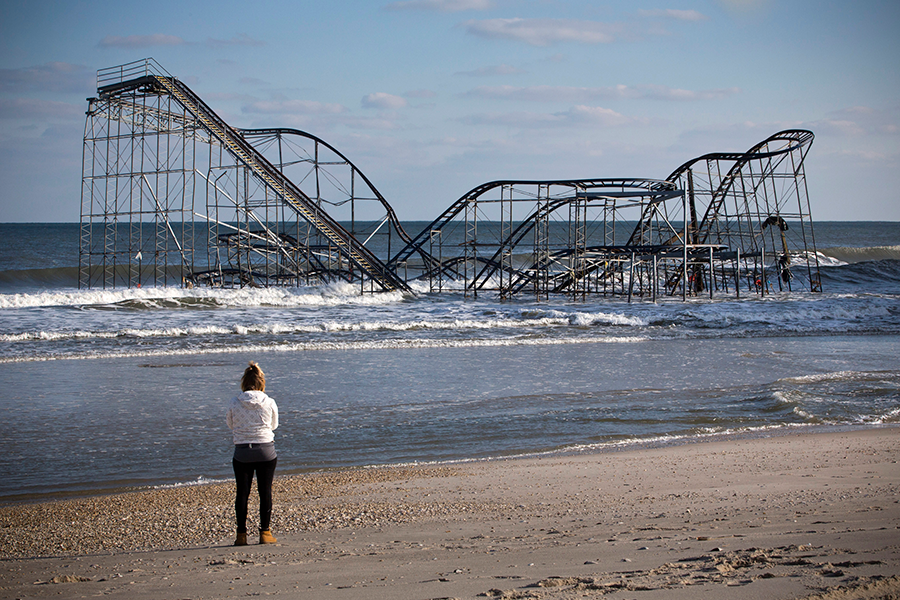125,000 years of ocean warming in 50 years: What does it mean for sea levels?
Loading...
What do Boston, Miami, and New Orleans have in common? All three may be almost completely underwater someday, if the results of a recent research paper are accurate.
The last time surface ocean temperatures were as warm as they are today, sea levels were 20 to 30 feet higher, according to findings published Friday in the journal Science. Using data from a wide range of locations, the study was able to measure regional temperature changes and concluded that recent models may be underestimating warming trends.
Earth’s climate features cyclical ice ages, when temperatures drop and ice sheets spread, causing ocean levels to fall. We currently enjoy the mild climate of what’s known as an “interglacial period,” when warmer temperatures melt ice, raising the seas. To better understand how our climate may develop in the future, experts consider the last interglacial period, 129,000 years ago, to be of great importance.
Getting a snapshot of what was going on so long ago isn’t easy, but scientists have a few tricks up their sleeves, such as measuring the makeup of ancient ice cores. This study used the composition of plankton shells (which depends on surface temperature) found in ocean sediments from 83 sites worldwide to compare our current interglacial period to the last one.
While it took a tipping of the planet’s axis 125,000 years to raise ocean temperatures by 0.9 degrees F., as The Los Angeles Times explained, current conditions have seen similar warming in less than 50, the paper found.
One degree may not seem like much in terms of the daily weather forecast, but it can have an outsized impact on sea levels. “The last interglacial is extremely interesting because it’s the last time period in recent Earth history when global temperatures were a little bit higher and global sea level was about 6 to 9 meters (20 to 30 feet) higher,” lead author Jeremy Hoffman told The LA Times.
“This tells us that the big ice sheets are really sensitive to just a little bit of warming,” Rob DeConto, a climate scientist at the University of Massachusetts, Amherst, who was not involved in the research, explained to The Guardian. “That’s a really powerful message.”
It’s also a familiar lesson to anyone who’s noticed how much faster ice cubes melt in a room-temperature drink than in a cold one.
Previous papers have predicted similar 20-foot ocean level rises, but this study paints a more nuanced picture of the past climate by drawing on data from dozens of locations, rather than just a few. Researchers concluded that climate change during the last interglacial period was uneven, with different regions warming, or even cooling, at different rates, something that mirrors what we’re seeing today.
The researchers also found that current climate models predicted less warming, on average, during the last interglacial period than the amount they actually measured, which has alarming consequences for future trends.
“This refined picture really clearly identifies that the modelling experiments do not create enough warming during the last interglacial,” Dr. Hoffman told The Guardian. “We think there might be some process missing that we’re just not capturing,” he continued. “If we’re missing something from this period of the Earth’s history, what might we be missing from future projections?”
Global sea rise is already underway: some 8 inches over the last century. The United Nations expects another 5 to 26 inches by 2050. If the current temperature has the same melting effect it did last time, 30 feet of rising waters could displace 643 million people worldwide – almost twice the population of the United States.
If there is a silver lining, it’s the long timescale: no risk of a "Day After Tomorrow" style insta-flood. “The good news is that with luck it will continue to rise slowly, so that we have time to adapt, but the bad news is that eventually all our present coastal city locations will be inundated,” University of Exeter climate scientist Andrew Watson told The Guardian.
But only if we use the time well. “We are rapidly approaching ocean conditions that haven’t been really seen on this planet for over 120,000 years,” Hoffman told The LA Times. “That’s a very relevant thing as we head into the next couple decades, and we start making policy decisions to turn this train around.”
You can check out how your city would handle 20 feet of water with nonprofit news organization Climate Central’s simulation.








